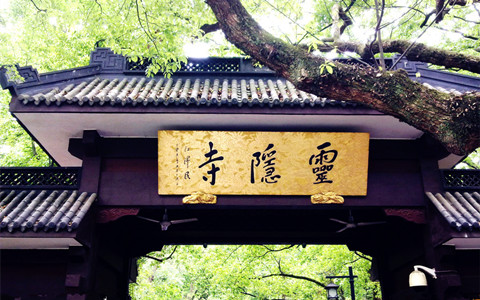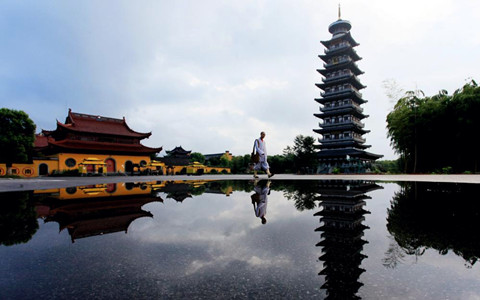The Lingyin Temple stands at the foot of the Beigao Peak and faces the Feilai (Peak That Flew Here) Peak across a stream. With many old trees, groves of bamboo, and quiet and beautiful surroundings, the Lingyin Temple is one of the most famous temples south of the Changjiang (Yangtze) River, and it attracts a great number of tourists from home and abroad.
There is a story about the Feilai Peak and the temple. The story is about Huili, a Buddhist monk from India who visited Wulin Hill (present Feilai Peak) in 326, the first year of the reign of Emperor Xian He of the Eastern Jin Dynasty (317-420). Huili insisted that the hill looked exactly like the Grdhrakuta in India and asked when the peak had flown to Hangzhou. To fortify his claim, he said that the Grdhrakuta had a white monkey and a black monkey in one of its caves. When the two monkeys were indeed found in a cave in the hill, it was recognized as the Feilai Peak (Peak That Flew Here). Later, the houses built there by Huili were called the Lingyin (Soul’s Retreat) Temple.

Over the past 1,600 years, the temple has been both ruined and rebuilt many times. It experienced its zenith during the Five Dynasties Period (907-960). The temple had 9 buildings, 18 towers, and 72 halls with 1,300 rooms and more than 3,000 monks.
Today, the Lingyin Temple is made up of the Hall of the Heavenly King, the Hall of the Great Hero, the Hall of the Buddha of Medicine, the East and West Winding Corridors, the west wing, the Liandeng Tower, the Dabei Tower, the Abbot’s Room, and the dining halls. The 33.6-meter-high Hall of the Great Hero is the temple’s most magnificent buildingIn the center of the Hall of the Great Hero, there is a magnificent statue of Sakyamuni that is 9.1 meters tall and is seated on a 10.5-meter-high pedestal. Carved out of 24 pieces of fragrant camphor wood and gilded in gold, the statue attracts groups of worshipers everyday.
